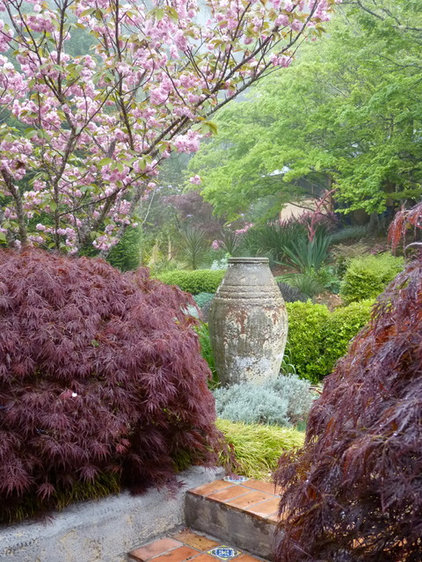 Arthur Lathouris Garden Designer
Japanese maples (Acer palmatum cvs) are suited for gardens in USDA zones 5 to 8 (Gainesville lawns are located in zone 8). They generally grow best in areas with morning sun and afternoon shade; red-leafed varieties can cope with more sun than can the green cultivars. Indeed, the sun intensifies the red pigments, which act as a sort of natural sunscreen. They prefer slightly moist, well-drained to average soil and require regular water (1 inch per week).
Arthur Lathouris Garden Designer
Japanese maples (Acer palmatum cvs) are suited for gardens in USDA zones 5 to 8 (Gainesville lawns are located in zone 8). They generally grow best in areas with morning sun and afternoon shade; red-leafed varieties can cope with more sun than can the green cultivars. Indeed, the sun intensifies the red pigments, which act as a sort of natural sunscreen. They prefer slightly moist, well-drained to average soil and require regular water (1 inch per week).The mounding red leaf form is the quintessential Japanese maple that immediately comes to mind. Popular cultivars include the older ‘Crimson Queen’ as well as more recent introductions such as ‘Tamukeyama’ and ‘Red Dragon’. These cut-leafed trees, botanically called dissectum, rarely surpass a height of 8 feet and a spread of 12 feet.
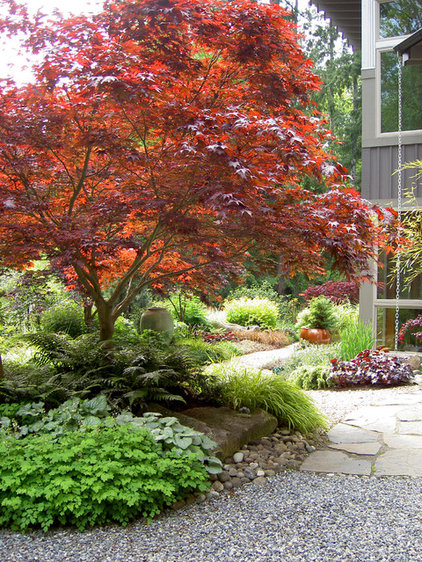 Bliss Garden Design
Other Japanese maples, such as the red-leafed‘Bloodgood’, Emperor 1 and coral bark maple (Acer palmatum ‘Sango Kaku’), have an upright growth pattern and typically reach 15 to 25 feet in height.
Bliss Garden Design
Other Japanese maples, such as the red-leafed‘Bloodgood’, Emperor 1 and coral bark maple (Acer palmatum ‘Sango Kaku’), have an upright growth pattern and typically reach 15 to 25 feet in height. Not all Japanese maples are created equal. My experience has shown that many people purchase upright varieties with the misconception that they will stay under 8 feet in height. A bit of research on the front end will spare you future disappointment.
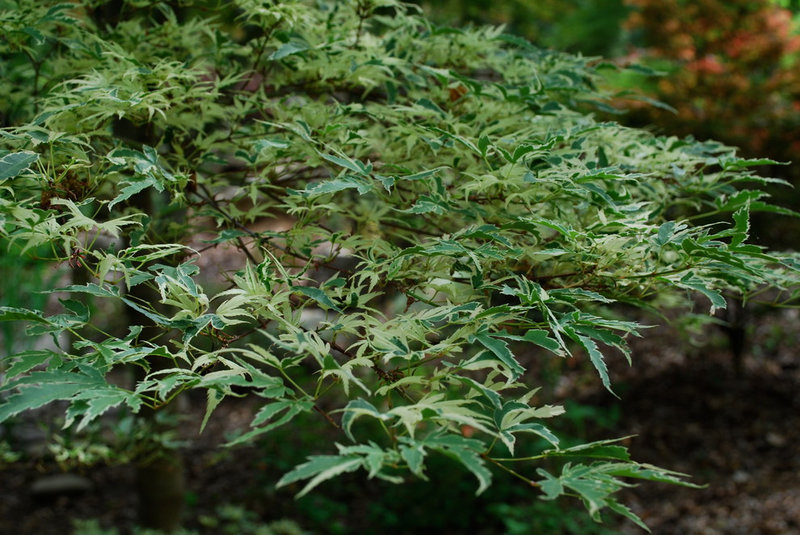 Jay Sifford Garden Design
Recently many new varieties of Japanese maples have been introduced into the market. Cultivars with variegated foliage have sparked particular interest. Perhaps your garden is in need of an update. A variegated Japanese maple may be just the thing to spark the renovation.
Jay Sifford Garden Design
Recently many new varieties of Japanese maples have been introduced into the market. Cultivars with variegated foliage have sparked particular interest. Perhaps your garden is in need of an update. A variegated Japanese maple may be just the thing to spark the renovation. ‘Butterfly’ is undoubtedly the best known variegated Japanese maple. This upright tree reaches an average height of 7 to 12 feet, making it a perfect focal point for a small urban garden. Its white and green variegated foliage brightens up a shady corner of the garden. The leaves may scorch in full sun. An occasional branch that sports solid green foliage is best removed.
‘Butterfly’ is beautifully suited for underplanting with a white variegated hosta, such as Patriot (Hosta ‘Patriot’, zones 3 to 8); River Mist Northern Sea Oats (Chasmanthium latifolium ‘River Mist’, zones 4 to 9); or a sea of glossy deep green holly ferns (Cyrtomium falcatum ‘Rochfordianum’, zones 6 to 10).
Similar varieties to consider would be the fastigiate ‘Orido Nishiki’ and the small, mounded‘Toyama Nishiki’.
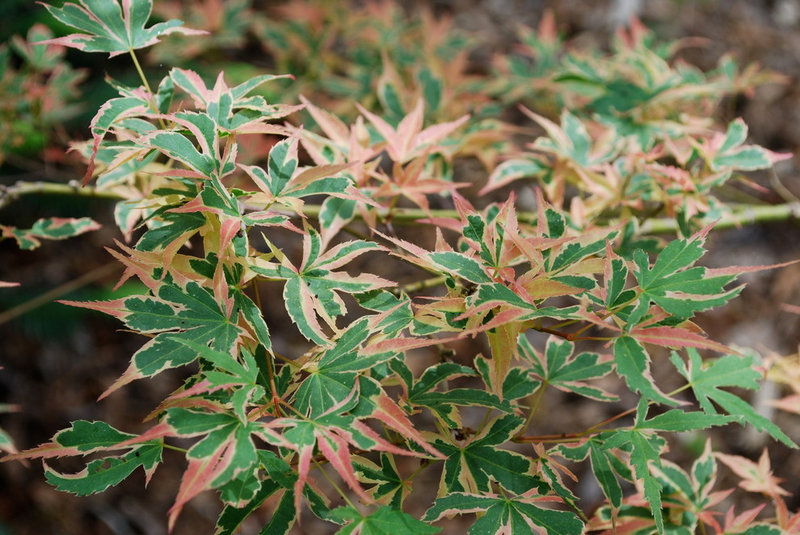 Jay Sifford Garden Design
‘Kagiri Nishiki’ is a beautiful cultivar similar to ‘Butterfly’ but with pink added into the mix. This upright tree grows to an average height of 10 to 15 feet with the right Gainesville fertilization program.
Jay Sifford Garden Design
‘Kagiri Nishiki’ is a beautiful cultivar similar to ‘Butterfly’ but with pink added into the mix. This upright tree grows to an average height of 10 to 15 feet with the right Gainesville fertilization program.Consider underplanting this variety with strawberry begonia (Saxifraga stolonifera, zones 6 to 9). This ground cover sports silvery white variegated foliage that’s pink underneath, with pink stems.
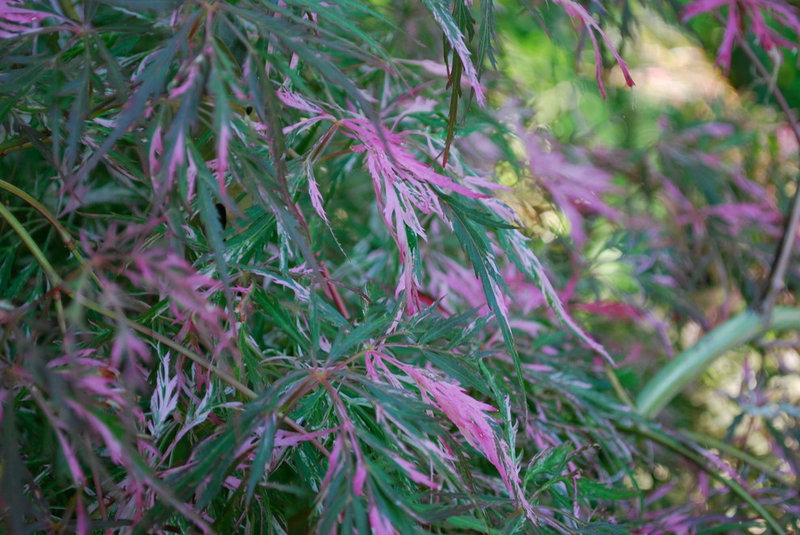 Jay Sifford Garden Design
I was speechless the first time I encountered ‘Hana Matoi’. This rare mounding dwarf reaches a 10-year height of only 2 to 3 feet on its own, so it is usually grafted onto a taller trunk. In spring the leaves emerge as a feisty mix of purple, pink and cream; the purple changes to green as temperatures warm, but the pink and cream remain well into the summer months.
Jay Sifford Garden Design
I was speechless the first time I encountered ‘Hana Matoi’. This rare mounding dwarf reaches a 10-year height of only 2 to 3 feet on its own, so it is usually grafted onto a taller trunk. In spring the leaves emerge as a feisty mix of purple, pink and cream; the purple changes to green as temperatures warm, but the pink and cream remain well into the summer months.‘Hana Matoi’ grows in my garden amidst pink Visions astilbe (Astilbe chinensis ‘Visions’,zones 4 to 8), where it makes a beautiful June display.
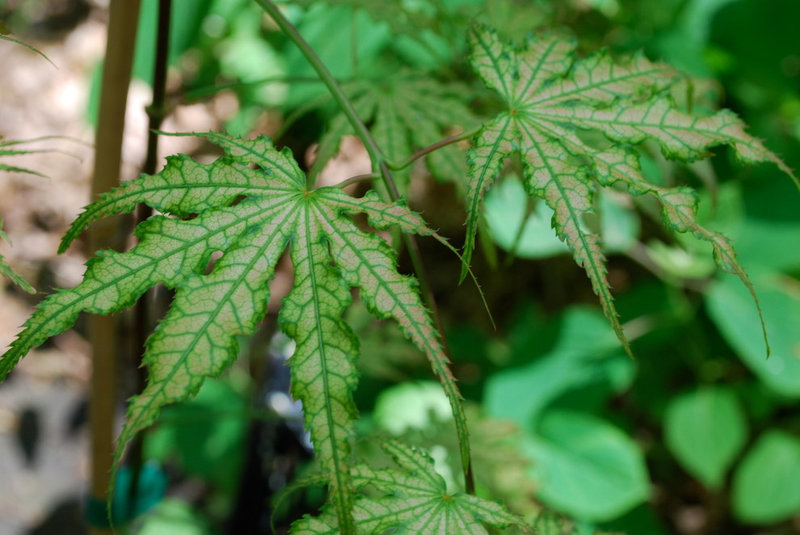 Jay Sifford Garden Design
‘Peaches and Cream’ has a delicate look and an endearing quality all its own. It reaches a height of 6 to 10 feet. Best grown in partial shade, it is small and the perfect understory tree in a woodland garden. A carpet of moss beneath this tree would be stunning.
Jay Sifford Garden Design
‘Peaches and Cream’ has a delicate look and an endearing quality all its own. It reaches a height of 6 to 10 feet. Best grown in partial shade, it is small and the perfect understory tree in a woodland garden. A carpet of moss beneath this tree would be stunning.
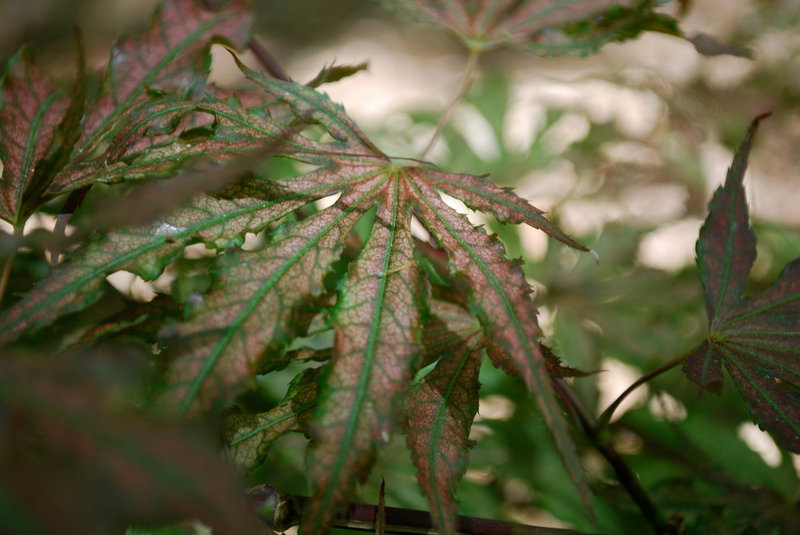 Jay Sifford Garden Design
‘Mikazuki’ is a relatively new cultivar; its name means “crescent moon.” The bronzy pink leaf tones, combined with bright green veining, make this tree a standout. Mikazuki grows to a height of 8 to 10 feet.
Jay Sifford Garden Design
‘Mikazuki’ is a relatively new cultivar; its name means “crescent moon.” The bronzy pink leaf tones, combined with bright green veining, make this tree a standout. Mikazuki grows to a height of 8 to 10 feet.
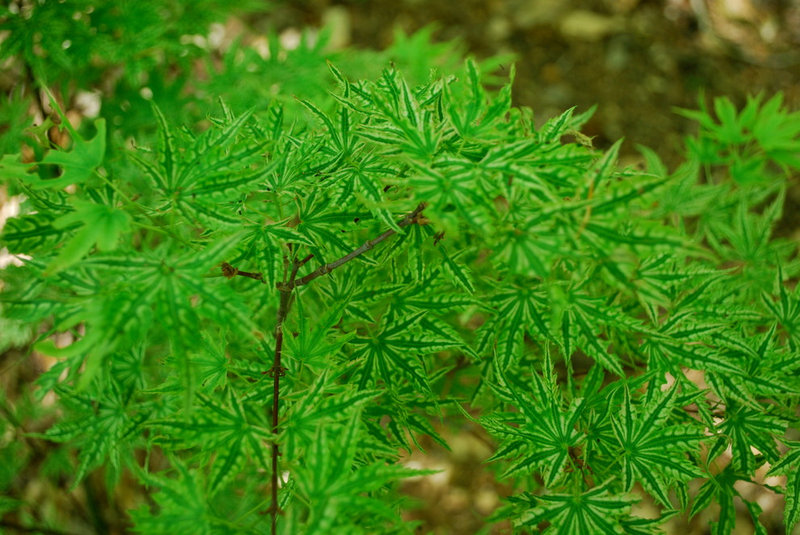 Jay Sifford Garden Design
‘Higasayama’ is a bright green beauty. This very hardy cultivar grows to a height of 20 to 25 feet. ‘Higasayama’ can handle full sun but maintains its best color in filtered shade.
Jay Sifford Garden Design
‘Higasayama’ is a bright green beauty. This very hardy cultivar grows to a height of 20 to 25 feet. ‘Higasayama’ can handle full sun but maintains its best color in filtered shade. This tree is best allowed to shine on its own. A large underplanting of a dark green fern, such as Japanese beech fern (Phegopteris decursive-pinnata, zones 4 to 10), would be appropriate.
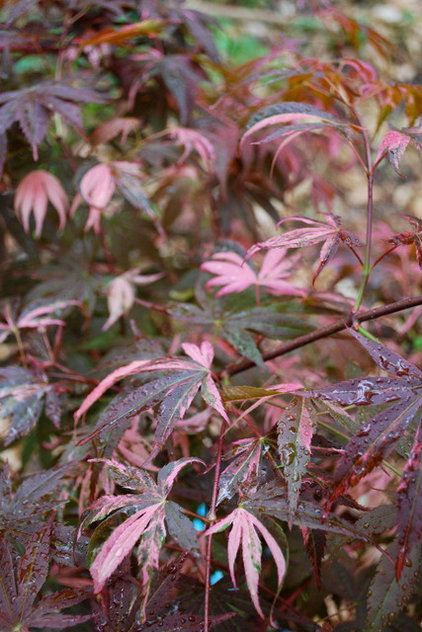 Jay Sifford Garden Design
‘Rainbow’ is a new variety that captures interest wherever it is grown. It’s dark maroon leaves are irregularly splashed with shades of pink. It reaches a height of 8 feet.
Jay Sifford Garden Design
‘Rainbow’ is a new variety that captures interest wherever it is grown. It’s dark maroon leaves are irregularly splashed with shades of pink. It reaches a height of 8 feet. Place ‘Rainbow’ near a path in a woodland garden where it can be appreciated.
 Jay Sifford Garden Design
‘Manyo no sato’ is a rare cultivar that is worth finding. It sports lime-green foliage heavily splashed with dark purple. This tree can handle more sun than many of the others; indeed, more sun intensifies its foliage color.
Jay Sifford Garden Design
‘Manyo no sato’ is a rare cultivar that is worth finding. It sports lime-green foliage heavily splashed with dark purple. This tree can handle more sun than many of the others; indeed, more sun intensifies its foliage color.This tree is underplanted with the sun-tolerant Inky Fingers coleus in my garden. The similarity of foliage color allows each plant’s shape, size and texture to really stand out.
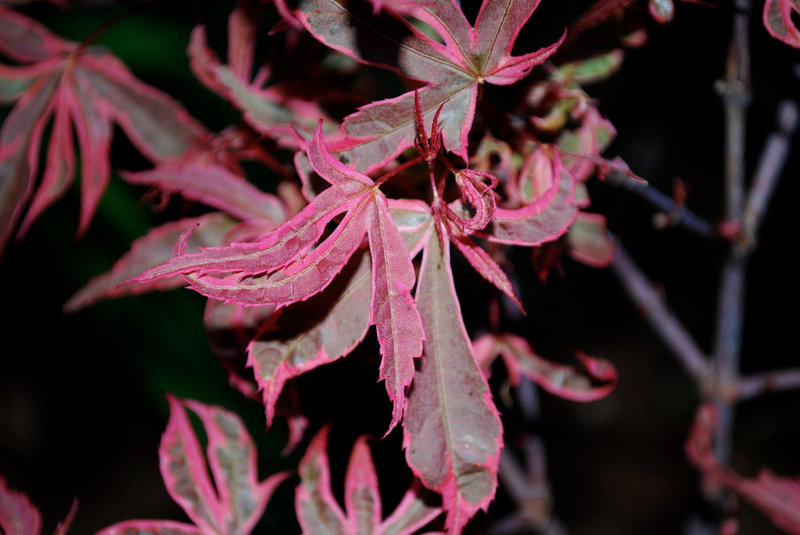 Jay Sifford Garden Design
‘Shirazz’ is always the star of the spring garden. This hardy cultivar from New Zealand grows to 20 feet in height and can handle more sun than many Japanese maple cultivars. As with ‘Manyo no sato’, more sun intensifies its foliage color.
Jay Sifford Garden Design
‘Shirazz’ is always the star of the spring garden. This hardy cultivar from New Zealand grows to 20 feet in height and can handle more sun than many Japanese maple cultivars. As with ‘Manyo no sato’, more sun intensifies its foliage color.‘Shirazz’ is very similar to the American-bred ‘Geisha Gone Wild’. Whichever one you purchase, be prepared to be wowed.
